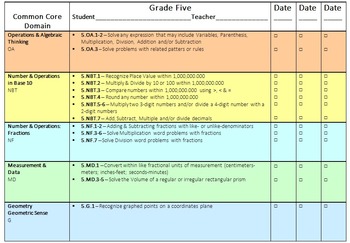Fifth Grade Common Core Math Assessment: Benchmark or Diagnostic
Mathemagicians and Word Wizards Enter Here
89 Followers
Grade Levels
3rd - 6th
Subjects
Resource Type
Standards
CCSS5.MD.A.1
CCSS5.NBT.A.1
CCSS5.OA.A.1
CCSS5.OA.A.2
CCSS5.OA.B.3
Formats Included
- PDF
Pages
11 pages
Mathemagicians and Word Wizards Enter Here
89 Followers
What educators are saying
This is a great assessment to use to find out where your students are at in all the math strands. I trach math intervention k-6 and have this assessment tool for all grade levels.
My students used it daily for their classes. It eased the burden off of me to have to create it in addition to teaching the material.
Description
Mathemagicians and Word Wizards Enter Here for a Fifth Grade Common Core Math Assessment. This test has multiple intended uses. Including:
1. Ensuring an end of the year 5th grader mastered all the Common Core Standards. (Summative Assessment)
2. Ensuring a beginning 6th grader mastered each of the 5th grade Common Core Standards (Summative Assessment)
3. Placing a 5th grader into an enrichment group. (Screening Assessment) and
4. Determining intervention areas needed to be covered for a student with specialized designed instruction.
(Diagnostic and Progress Monitoring Assessment)
1. Ensuring an end of the year 5th grader mastered all the Common Core Standards. (Summative Assessment)
2. Ensuring a beginning 6th grader mastered each of the 5th grade Common Core Standards (Summative Assessment)
3. Placing a 5th grader into an enrichment group. (Screening Assessment) and
4. Determining intervention areas needed to be covered for a student with specialized designed instruction.
(Diagnostic and Progress Monitoring Assessment)
Total Pages
11 pages
Answer Key
Included
Teaching Duration
30 minutes
Report this resource to TPT
Reported resources will be reviewed by our team. Report this resource to let us know if this resource violates TPT’s content guidelines.
Standards
to see state-specific standards (only available in the US).
CCSS5.MD.A.1
Convert among different-sized standard measurement units within a given measurement system (e.g., convert 5 cm to 0.05 m), and use these conversions in solving multi-step, real world problems.
CCSS5.NBT.A.1
Recognize that in a multi-digit number, a digit in one place represents 10 times as much as it represents in the place to its right and 1/10 of what it represents in the place to its left.
CCSS5.OA.A.1
Use parentheses, brackets, or braces in numerical expressions, and evaluate expressions with these symbols.
CCSS5.OA.A.2
Write simple expressions that record calculations with numbers, and interpret numerical expressions without evaluating them. For example, express the calculation “add 8 and 7, then multiply by 2” as 2 × (8 + 7). Recognize that 3 × (18932 + 921) is three times as large as 18932 + 921, without having to calculate the indicated sum or product.
CCSS5.OA.B.3
Generate two numerical patterns using two given rules. Identify apparent relationships between corresponding terms. Form ordered pairs consisting of corresponding terms from the two patterns, and graph the ordered pairs on a coordinate plane. For example, given the rule “Add 3” and the starting number 0, and given the rule “Add 6” and the starting number 0, generate terms in the resulting sequences, and observe that the terms in one sequence are twice the corresponding terms in the other sequence. Explain informally why this is so.


